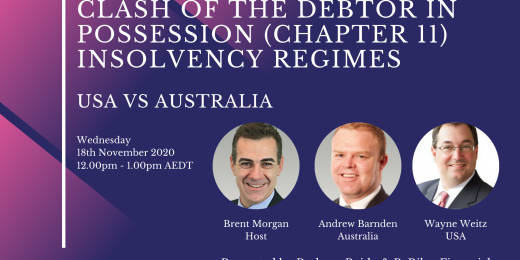Webinar Recap 18 November 2020: Australia vs USA Clash of the Debtor in Possession.
Share

Rodgers Reidy hosted an insightful webinar on 18 November 2020, featuring Wayne Weitz from B. Riley Financial (USA) and Andrew Barnden from Rodgers Reidy (Aus), with others as they explored the new Debtor in Possession rules that will be used in Australia.
Australia is following down the path of a Chapter 11 bankruptcy program, with a new regime following the Debtor in Possession model. In this Webinar, we discuss how it works in the USA and what Australia’s program might be like in comparison. Below is a recording of the webinar and your Q&A’s answered.
Q&A
Q: Why is this legislation only focused on SME’s (less than $1M debt)? What alternatives are available for larger companies?
A: The draft legislation is designed for the SME market where non-related unsecured debts are less than $1m. In this regard, ASIC data shows that 78% of all external administrations in Australia have non-related unsecured debts of less than $1m. In the event that a company in financial difficulty has unsecured debts of greater than $1m, then the other existing alternatives under the Corporations Act are available – e.g. Voluntary Administration, Safe Harbour or Creditors Voluntary Liquidation.
Q: Does it include secured creditors?
A: From my reading of the draft legislation, secured creditors should be able to vote for the estimated shortfall of their debt after reasonably allowing for their security.
Q: Who is liable for debts during the 40 day process, do these debt included in restructure proposal?
A: Unlike the current Voluntary Administration process where the Voluntary Administrator is personally liable for any debts incurred during the administration, under the Small Business Restructuring process, there is no such provisions and the company will be liable to meet any debts incurred during that time.
Q: How is a business restructuring practitioner appointed?
A: The Small Business Restructuring Practitioner will be appointed by way of a resolution of the board of directors of the company in financial difficulty.
Q: Do you think Australian SMEs have access to DIP finance in the current market?
A: Whilst DIP finance is a common thing in the US, due to the relatively small size of these matters (less than $1m in unsecured creditors) and the limited security available, together with the unknown of this new restructuring process, I don’t think such finance will be readily available in Australia in the short term (noting that it is not that common in the VA process either).
Q: Based on your experience as an administrator and liquidator, what portion of companies do you expect will be able to take advantage of this process having regard to the requirements for up to date lodgements and fully paid employee entitlements? I cannot think of any that I have been involved in?
A: Time will tell whether this Debtor in Possession model will work, however, the need to pay all due and payable employee entitlements (eg superannuation), together with having all taxation lodgements up to date, in my opinion will be a significant hurdle for SME companies to enter into this process.
Q: Can director guarantees still be pursued?
A: From my reading of the draft legislation, like a VA process, directors guarantees will not be able to be pursued during the 40 business day period whilst the proposal is being drafted and put to creditors.






